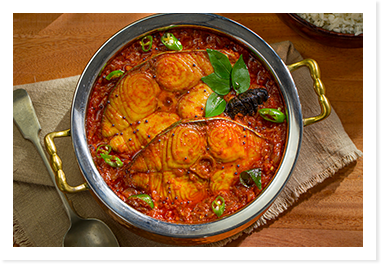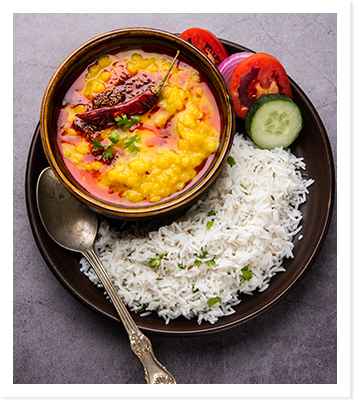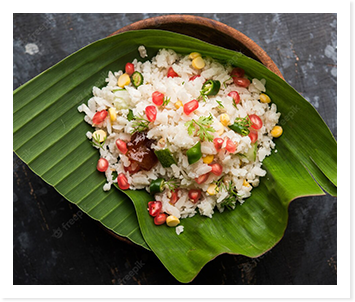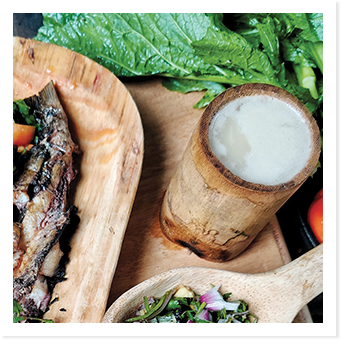

Assamese cuisine reflects its culture and traditions which has its own style and pattern, quite distinct from the rest of the country as well as the other North-eastern states. The traditional food of Assam comes across as a blend of many exotic spices, herbs and condiments. With a wide variety of food to offer, the cuisine of Assam is famous for its distinctive flavouring and influences. The delicacies of Assam boast of a unique charm derived from exotic herbs and vegetables that are used in the dishes adding freshness and magnificent taste. The speciality of Assamese cuisine is that it is prepared with less spices and oil. The zest of its raw flavours will surely leave a mark on your heart, mind and taste buds for a long time.
The food culture of the state is diverse since it is an ethnically diverse state. As simple as Assamese people are, their way of life is reflected in their food preparation. However if you are in Assam, you should not miss Assamese cuisine and try these mouth-watering delicacies.
A traditional meal in Assam comprises of daal, leafy vegetables (xaak), fish (maas) meat (mangkho), khar (alkaline dish), sour dishes (tenga) and a slice of the famous Assamese lemon (nemu). Although all Assamese people cannot be categorised as non-vegetarians but they have their share of flesh for every special occasion be it a pigeon meat, pork, chicken, mutton or a duck roast. Ideally the traditional meal starts with khar (alkaline dish) and ends with a tenga jhul (sour curry) mostly made with fish.
For the vegetarians, the meal is served with various locally grown vegetables. Ideally the traditional meal begins with a khar (alkaline dish) and ends with a tenga (sour curry mostly made with fish) mostly made with fish. Various preparations of vegetables and meat like pigeon, chicken, duck, pork is also served in the meal. Tamul Paan (areca nut with betel leaf) generally raw concludes the meal.

The blessed land, Assam is home to the river Brahmaputra. With so many rivers and various other fresh water resources like Pukhuri (pond) at the backyard, the state is endowed with variety of delicious fish species like puthi, dorikona, goroi, kawoi, muwa, hingora, rou etc. will tickle your taste buds with their umpteen flavours. With such availability of variety of fishes you can try different fish recipes like tenga anjaa, sorsori, patot diya, sungaat diya, depending on which variety you are relishing.


The following are some Assamese dishes which you can relish it for a lifetime
Jolpaan means breakfast in Assamese which is a light snack that is consumed between two meals, although these snacks can be eaten at any time of the day. It basically comprise items that do not require elaborate cooking or can be prepared just ahead of time. Jolpaan is integral to festivals, weddings and even served in funerals. It usually consists of various forms of rice like bora saul, chira, kumol saul, pithaguri, xaandoh, muri which is generally served with cream, curd or jaggery.Till a decade back, grains were pounded on a dheki (a traditional pounding contraption operated manually with feet). However, with passing time or timelessness mills have started replacing this system in case of mass production. The typical Assamese Jolpaan include chira, doi, akhoi, pitha-guri, sandoh guri, muri, with a sonda-kol or malbhog kol (local varieties of bananas)


Jolpaan means breakfast in Assamese which is a light snack that is consumed between two meals, although these snacks can be eaten at any time of the day. It basically comprise items that do not require elaborate cooking or can be prepared just ahead of time. Jolpaan is integral to festivals, weddings and even served in funerals. It usually consists of various forms of rice like bora saul, chira, kumol saul, pithaguri, xaandoh, muri which is generally served with cream, curd or jaggery.Till a decade back, grains were pounded on a dheki (a traditional pounding contraption operated manually with feet). However, with passing time or timelessness mills have started replacing this system in case of mass production. The typical Assamese Jolpaan include chira, doi, akhoi, pitha-guri, sandoh guri, muri, with a sonda-kol or malbhog kol (local varieties of bananas)

Bora saul (sticky rice) is a variety of Assamese sticky rice mostly eaten as a snack, however it is also used for making pithas (pancakes). Pithas are sweet delicacy prepared from rice flour which has many different types. Rice flour mixed with jaggery and sesame is steamed, cooked or fried to make different types of pithas. Pithas are indispensable during festivals such as Bihu and also on weddings. However, one requires a lot of precision to make pithas. The varieties of pitha that are made in Assam are ghila pitha, til pitha, narikol pitha, til pitha, tekelir mukhot diya pitha, sunga pitha etc.

Bora saul (sticky rice) is a variety of Assamese sticky rice mostly eaten as a snack, however it is also used for making pithas (pancakes). Pithas are sweet delicacy prepared from rice flour which has many different types. Rice flour mixed with jaggery and sesame is steamed, cooked or fried to make different types of pithas. Pithas are indispensable during festivals such as Bihu and also on weddings. However, one requires a lot of precision to make pithas. The varieties of pitha that are made in Assam are ghila pitha, til pitha, narikol pitha, til pitha, tekelir mukhot diya pitha, sunga pitha etc.
Chira (flattened rice) and muri (puffed rice) are both eaten as snacks as well as breakfast cereals. Kumol saol is a variety of soft rice in Assam which can be consumed without cooking. The rice is soaked in water for a few hours, drained and then mixed with milk, cream or curd and a small amount of jaggery.


Chira (flattened rice) and muri (puffed rice) are both eaten as snacks as well as breakfast cereals. Kumol saol is a variety of soft rice in Assam which can be consumed without cooking. The rice is soaked in water for a few hours, drained and then mixed with milk, cream or curd and a small amount of jaggery.
Khar is prepared by burning the stem of the banana tree or from the ashes of banana peel. Khar is also used with other ingredients such as raw banana and lentils to make dishes. Khar is so much an integral part of Assamese cuisine that many people use to describe the people of Assam as ‘Khar Khuwa Asomiya’. It is believed that khar cleanses the stomach and thus has many health benefits.
This classic preparation’s main ingredient is made by filtering water through the ashes of banana tree. The resultant stock, known as kola khar, is used with other ingredients such as raw banana and lentils to make dishes. The stock is believed to have high medicinal value.
Khar is prepared by burning the stem of the banana tree or from the ashes of banana peel. Khar is also used with other ingredients such as raw banana and lentils to make dishes. Khar is so much an integral part of Assamese cuisine that many people use to describe the people of Assam as ‘Khar Khuwa Asomiya’. It is believed that khar cleanses the stomach and thus has many health benefits.
This classic preparation’s main ingredient is made by filtering water through the ashes of banana tree. The resultant stock, known as kola khar, is used with other ingredients such as raw banana and lentils to make dishes. The stock is believed to have high medicinal value.
Assamese food will be very incomplete if we do not mention about fish. In almost every households of Assamese people, a meal is incomplete without a dish with fish as the main ingredient. Assamese fish preparation is the distinctly sour tasting ‘maasor tenga’. Tenga is an indispensable part of a meal in Assam. The meal is prepared with bilahis (tomatoes) which is the souring ingredient. The dish has a unique tangy flavour and carries a rich flavour of a fried fish. Not only bilahis are used during fish preparation but it can be other souring agent like nemu (lemon) thekera, ou tenga (elephant apple), kon bilahi (cherry tomatoes), tenga mora (roselle leaves) tenegesi(sorrel) kesa aam (raw mango). Maasor tenga tastes best in summer heat. Maasor tenga is all time favourite in almost every households and is enjoyed best with steamed rice. This meal is very light and is very nutritious. It will not only calm your tummy but will satiate your palate as well.


Assamese food will be very incomplete if we do not mention about fish. In almost every households of Assamese people, a meal is incomplete without a dish with fish as the main ingredient. Assamese fish preparation is the distinctly sour tasting ‘maasor tenga’. Tenga is an indispensable part of a meal in Assam. The meal is prepared with bilahis (tomatoes) which is the souring ingredient. The dish has a unique tangy flavour and carries a rich flavour of a fried fish. Not only bilahis are used during fish preparation but it can be other souring agent like nemu (lemon) thekera, ou tenga (elephant apple), kon bilahi (cherry tomatoes), tenga mora (roselle leaves) tenegesi(sorrel) kesa aam (raw mango). Maasor tenga tastes best in summer heat. Maasor tenga is all time favourite in almost every households and is enjoyed best with steamed rice. This meal is very light and is very nutritious. It will not only calm your tummy but will satiate your palate as well.
Pitika means mash; and the most comfort food of Assamese people is aloo Pitika-mashed potatoes garnished with finely chopped onions, green chillies, and coriander. It is enjoyed with a plate of rice and dal that forms the heart of a humble of Assamese meal.
Pitika means mash; and the most comfort food of Assamese people is aloo Pitika-mashed potatoes garnished with finely chopped onions, green chillies, and coriander. It is enjoyed with a plate of rice and dal that forms the heart of a humble of Assamese meal.
(Tangy Fish Curry): An assamese meal is not considered complete without atleast one fish preparation. Both lunch and dinner feature at the minimum, a dish with fish as the main ingredient. A classic Assamese fish preparation is the distinctly sour tasting maasor tenga. It is prepared with bilahi (tomatoes),or any other souring agent like nemu (lemon), thekera (a sour fruit indigenous to Assam), ou tenga (elephant apple), kon bilahi (cherry tomatoes), tenga mora (roselle leaves), tengesi (sorrel) kesa aam (raw mango). It is all time favourite in almost every households and is enjoyed best with steamed rice. This meal is very light and is very nutritious and will satiate your palate as well.
(Tangy Fish Curry): An assamese meal is not considered complete without atleast one fish preparation. Both lunch and dinner feature at the minimum, a dish with fish as the main ingredient. A classic Assamese fish preparation is the distinctly sour tasting maasor tenga. It is prepared with bilahi (tomatoes),or any other souring agent like nemu (lemon), thekera (a sour fruit indigenous to Assam), ou tenga (elephant apple), kon bilahi (cherry tomatoes), tenga mora (roselle leaves), tengesi (sorrel) kesa aam (raw mango). It is all time favourite in almost every households and is enjoyed best with steamed rice. This meal is very light and is very nutritious and will satiate your palate as well.
Patot diya is a quintessential delicacy made by marinating fish in a paste made of ginger, garlic, onion and mustard paste, sprinkled with salt and turmeric powder. The fish is then wrapped in a banana leaves and roasted directly in a directly wood fire. A simple soulful dish that captures the true essence of Assamese cooking.
Patot diya is a quintessential delicacy made by marinating fish in a paste made of ginger, garlic, onion and mustard paste, sprinkled with salt and turmeric powder. The fish is then wrapped in a banana leaves and roasted directly in a directly wood fire. A simple soulful dish that captures the true essence of Assamese cooking.
Laai Xaak Gahori is a popular dish of Assam. This dish celebrates simplicity, letting its natural ingredients speak for themselves. Tender cuts of pork are slow cooked with crushed ginger- garlic paste, green chillies and just a touch of turmeric and salt. The magic unfolds when fresh laai Xaak is added and cooked until the leavesshrink and their distinct flavour. The dish is considered heavenly when served with a plate of hot and plain rice.
Laai Xaak Gahori is a popular dish of Assam. This dish celebrates simplicity, letting its natural ingredients speak for themselves. Tender cuts of pork are slow cooked with crushed ginger- garlic paste, green chillies and just a touch of turmeric and salt. The magic unfolds when fresh laai Xaak is added and cooked until the leavesshrink and their distinct flavour. The dish is considered heavenly when served with a plate of hot and plain rice.
A classic Assamese winter delicacy, Haah Joha Kumura is prepared using a special variety of ash gourd known as joha kumura, which releases a subtle, fragrant aroma similar to joha rice when cooked. The dish relies on simple, traditional spicesginger, garlic and green chilliesto bring out its natural flavours. Slow-cooked over a wood fire, the duck meat becomes tender, rich and irresistibly delicious, making this dish a cherished favourite during the colder months.
A classic Assamese winter delicacy, Haah Joha Kumura is prepared using a special variety of ash gourd known as joha kumura, which releases a subtle, fragrant aroma similar to joha rice when cooked. The dish relies on simple, traditional spicesginger, garlic and green chilliesto bring out its natural flavours. Slow-cooked over a wood fire, the duck meat becomes tender, rich and irresistibly delicious, making this dish a cherished favourite during the colder months.
Some Traditional Snacks and Dishes
Til Pitha is one of Assam’s most loved Bihu delicacies, especially enjoyed during Magh Bihu. It is a soft rice-flour crepe filled with roasted black sesame seeds mixed with jaggery. The thin outer layer melts beautifully, releasing the warm, nutty sweetness inside. Prepared with great patience and skill, it reflects the artistry of Assamese home cooking. Til Pitha is more than food—it is a symbol of festivity, warmth, and tradition.


Til Pitha is one of Assam’s most loved Bihu delicacies, especially enjoyed during Magh Bihu. It is a soft rice-flour crepe filled with roasted black sesame seeds mixed with jaggery. The thin outer layer melts beautifully, releasing the warm, nutty sweetness inside. Prepared with great patience and skill, it reflects the artistry of Assamese home cooking. Til Pitha is more than food—it is a symbol of festivity, warmth, and tradition.
Ghila Pitha, also called tel pitha, derives its name from its round, “ghila”-like shape and is made during Bihu and special occasions. Prepared using rice powder and jaggery, it is deep-fried to a golden crisp. Its slightly chewy centre and caramelised sweetness make it a comforting treat. Served warm, it brings families together around the traditional Bihu hearth. Ghila Pitha is a true reminder of rural Assam’s simplicity and charm.
Ghila Pitha, also called tel pitha, derives its name from its round, “ghila”-like shape and is made during Bihu and special occasions. Prepared using rice powder and jaggery, it is deep-fried to a golden crisp. Its slightly chewy centre and caramelised sweetness make it a comforting treat. Served warm, it brings families together around the traditional Bihu hearth. Ghila Pitha is a true reminder of rural Assam’s simplicity and charm.
Tilor Laru is a favourite Assamese sweet made from roasted sesame seeds and jaggery. Rolled lovingly into small spheres, these larus carry warmth, aroma, and tradition. They are especially prepared during Magh Bihu, symbolising abundance and togetherness. Each bite bursts with a nutty crunch and rich sweetness. Tilor Laru remains a timeless winter treat in Assamese households.
Tilor Laru is a favourite Assamese sweet made from roasted sesame seeds and jaggery. Rolled lovingly into small spheres, these larus carry warmth, aroma, and tradition. They are especially prepared during Magh Bihu, symbolising abundance and togetherness. Each bite bursts with a nutty crunch and rich sweetness. Tilor Laru remains a timeless winter treat in Assamese households.
Made from freshly grated coconut and jaggery or sugar, Narikolor Laru is soft, fragrant, and comforting. Its delicate sweetness and melt-in-the-mouth texture make it a beloved festive sweet. Prepared during Bihu and family gatherings, it reflects homely warmth and care. The aroma of slow-cooked coconut fills the kitchen with nostalgia. Narikolor Laru is a cherished symbol of celebration in Assam.
Made from freshly grated coconut and jaggery or sugar, Narikolor Laru is soft, fragrant, and comforting. Its delicate sweetness and melt-in-the-mouth texture make it a beloved festive sweet. Prepared during Bihu and family gatherings, it reflects homely warmth and care. The aroma of slow-cooked coconut fills the kitchen with nostalgia. Narikolor Laru is a cherished symbol of celebration in Assam.
Kumol Saul or magic rice is a unique variety of rice which does not need cooking or boiling. Soaking in water softens it and makes it ready to eat. Kumol Saulor Jolpan is a traditional Assamese breakfast made with soft, parboiled rice. It is usually enjoyed with milk, curd, jaggery, or banana for a simple yet wholesome meal. The rice requires no cooking—just a quick wash—making it convenient and nutritious. Its light texture and subtle flavour offer refreshing comfort. Kumol Saulor Jolpan reflects the purity and simplicity of Assamese culinary heritage.


Kumol Saul or magic rice is a unique variety of rice which does not need cooking or boiling. Soaking in water softens it and makes it ready to eat. Kumol Saulor Jolpan is a traditional Assamese breakfast made with soft, parboiled rice. It is usually enjoyed with milk, curd, jaggery, or banana for a simple yet wholesome meal. The rice requires no cooking—just a quick wash—making it convenient and nutritious. Its light texture and subtle flavour offer refreshing comfort. Kumol Saulor Jolpan reflects the purity and simplicity of Assamese culinary heritage.
Assam tea is celebrated worldwide for its bold flavour, rich colour, and signature malty taste. Its history traces back to the early 19th century, when the Singpho people’s indigenous tea plants were recognised by the British, leading to the establishment of the first commercial plantations. By the 1830s, the Assam Tea Company pioneered large-scale production, shaping the global tea industry. Today, tea gardens stretch across the Brahmaputra valley, nurtured by fertile soil and humid climate. Each cup reflects the hard work of tea workers and the heritage of a region built on tea. Assam tea remains both an international favourite and a cultural identity for the state.
Assam tea is celebrated worldwide for its bold flavour, rich colour, and signature malty taste. Its history traces back to the early 19th century, when the Singpho people’s indigenous tea plants were recognised by the British, leading to the establishment of the first commercial plantations. By the 1830s, the Assam Tea Company pioneered large-scale production, shaping the global tea industry. Today, tea gardens stretch across the Brahmaputra valley, nurtured by fertile soil and humid climate. Each cup reflects the hard work of tea workers and the heritage of a region built on tea. Assam tea remains both an international favourite and a cultural identity for the state.
Falap, the traditional tea of the Singpho community, represents one of the earliest tea practices in Assam. Fresh leaves are steamed, packed tightly into bamboo tubes, and allowed to ferment or smoke for months. This unique process gives Falap its earthy flavour, deep aroma, and naturally smooth finish. Consumed without milk or sugar, it honours the Singpho philosophy of simplicity and purity. For the Singphos, Falap is not merely a beverage but a cultural inheritance that predates modern tea production. It stands as a living reminder of Assam’s original tea heritage.


Falap, the traditional tea of the Singpho community, represents one of the earliest tea practices in Assam. Fresh leaves are steamed, packed tightly into bamboo tubes, and allowed to ferment or smoke for months. This unique process gives Falap its earthy flavour, deep aroma, and naturally smooth finish. Consumed without milk or sugar, it honours the Singpho philosophy of simplicity and purity. For the Singphos, Falap is not merely a beverage but a cultural inheritance that predates modern tea production. It stands as a living reminder of Assam’s original tea heritage.
Rice predominate the Assamese cuisine and is considered the hallmark of fortune. Assam takes pride in retaining over 200 varieties of rice which is the staple food of the land. Our Tribes use rice to its optimum when it comes to it’s consumption. If we talk about our cuisine and we don’t talk about our rice beer, it would be a story half told. Our tribes in Assam use rice to prepare various types of rice beers and these ethnic wines are a story that needs our focus. Each of these ethnic beers are diverse, when it comes to their local names, flavours, textures, tastes and the aromas. For the tribes, the rice beers are of higher esteem and a mark of highest respect. The rice beers of the each tribes and sub tribes are unique, delicate and subtle. Be it any form of their get together, weddings, deaths, offering to their respective deities, community feasting or showcasing their traditions; these delicately prepared beers are a part of the ritual and also their cuisine and are consumed with fervour. Each tribe has its own style of preparation and particular names for their ethnic rice beer.
The Karbi tribe calls their rice beer HARLANG, the Bodo and Tiwa tribe calls it JOU, Mising Tribes prepare NAGIN APONG and PO:RO APONG and the Rabhas makes their unique beer and call it MATHA MOD and ROSHI MOD. The Ahoms are known for their LUK-LAU, the Sonowal-Kacharis take pride in their ROCHI MOD, the Dimasa wine is known as JUDIMA, the Deuri tribe has its SUJE and the Hajang consume JATHA KASA and RUHI, while the Garo tribe prepares CHU. The rice beers are traditionally made and very delicately handled by the expert hands, carefully treating the rice, handpicking the herbs from the forests, making an offering to their respective gods and then finally filtering the beer. The process itself is very delicate and hence, regarded as pious and pure. Once prepared, it is offered to the gods in their prayers, sacred rituals etc. The making of the beer to its consumption is a journey that needs to be experienced and hence Tourism around beer is the need of the hour

Mother Nature has blessed Assam with abundance of vegetables owing to the state fertile soil. The collective term for vegetables is known as haak pasoli. Dhekiya(ferns), xorioh paat(mustard greens), laai haak, jika, lau are the most popular vegetables. The sheer variety of vegetables is amazing in the state of Assam.